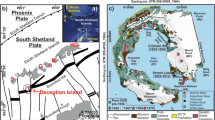Abstract
The results of geological, geochemical and isotopic investigations in the Hengill thermal area in Iceland are presented. This area may be regarded as typical of the Icelandic high temperature areas.
The Hengill area is mainly built up of pillow lavas and hyaloclastites, which were piled up in subglacial eruptions. Its western half is traversed by a very active NE-SW trending fault zone about 5 km broad, within which are several eruptive fissures of postglacial age. The volcanic rocks are basalts of various kinds, but minor occurrences of intermediate and rhyolitic rocks are also found.
Solfataras and fumaroles occur mainly at higher altitude. Within the fault zone they have a linear distribution along faults. Hot water springs are found in the lowlands on the southern border of the thermal area. The concentrations of chlorine, tritium and deuterium in the water indicate that the hot springs on the lowland are fed by a deep lying aquifer which receives water from a recharge area situated in the western branch of the active volcanic zone upto 70 km to the northeast. The hot springs at higher altitude are the outlets of a secondary circulation system fed by local rain water. This water derives its heat partly from the heat content of the rocks penetrated and partly by steam and gas boiled off from the deeper lying aquifer. Preliminary results from other high temperature areas in Iceland indicate the presence of similar hydrological systems.
Similar content being viewed by others
References
Árnason, B., andTh. Sigurgeirsson, 1967,Hydrogen isotopes in hydrological studies in Iceland. In:Isotopes in Hydrology, 35–46. IAEA, Vienna.
Bodvarsson, G., 1954,Terrestrial heat balance in Iceland. Timarit V.F.Í.,39, 69–76.
-----, 1960,Hot springs and the exploitation of natural heat resources. In:On the Geology and Geophysics of Iceland, 46–54, Int. Geol. Congr. Norden.
—————, 1961,Physical characteristics of natural heat resources in Iceland, Jökull,11, 29–38.
—————, 1962,The use of isotopes of hydrogen and oxygen for hydrological purposes in Iceland. Jökull,12, 49–54.
Einarsson, Tr., 1950,On the nature of thermal activity. (In Icelandic). Printed in Tímarit V. F. Í.,51, 23–32 (1966).
Friedman, I., Th. Sigurgeirsson andÖ. Gardarsson, 1963,Deuterium in Icelandic waters. Geochim. et Cosmochim. Acta,27, 533–561.
Jónsson, J. 1961,Jardhiti (Thermal activity). (In Icelandic). In:Náttúra Íslands, 95–120, Almenna Bókafélagid, Reykjavík, Iceland.
Pálmason, G., 1967,On heat flow in Iceland in relation to the Mid-Atlantic Ridge. In:Iceland and Mid-Ocean Ridges. Soc. Sci. Isl. « Rit »38, 111–127.
Saemundsson, K., 1967,Vulkanismus und Tektonik des Hengill-Gebietes. Acta nat. Isl. II, no. 7, 101 pp.
Sigurdsson, H., 1966,Geology of the Setberg area, Snaefellsnes, western Iceland. Soc. Sci. Isl. « Greinar » IV, 2, 53–125.
Sigvaldason, G. E., 1963,Epidote and related minerals in two deep geothermal drill holes, Reykjavík and Hveragerdi, Iceland, U. S. Geol. Surv. Prof. Paper 450-E, 77–79.
Walker, G. P. L., 1963,The Breiddalur central volcano, eastern Iceland. Quart. J. Geol. Soc. Lond.119, 29–63.
Author information
Authors and Affiliations
Rights and permissions
About this article
Cite this article
Arnason, B., Theodorsson, P., Björnsson, S. et al. Hengill, a high temperature thermal area in Iceland. Bull Volcanol 33, 245–259 (1969). https://doi.org/10.1007/BF02596720
Received:
Issue Date:
DOI: https://doi.org/10.1007/BF02596720




